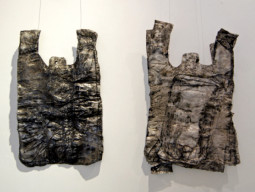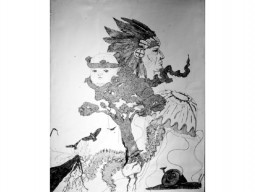
When Naiza Khan first discovered Manora — an island at the tip of Karachi’s coast marked with the vicissitudes of time and left behind like a forgotten limb, nostalgic to be whole again — she had little idea that a quiet walk away from her studio would lead to an exchange of conversation, metaphor and visual ethnography.
Khan is exhibiting a body of work titled, “The Weight of Things,” at Khaas Gallery as a visual trajectory of her unravelling relationship with the island, its history and the architecture of the ocean that removes it from the restless mass of land that is her own native, Karachi.
In a sense, Khan’s work strives to archive her own experience with Manora, not unlike an anthropologist or historian, except that the Claus laureate’s lens is visceral, her observations often driven through imagination, rooted in the desire to unfold the complex narrative that branches from her interaction with the island, its people and topography. She was awarded the prestigious Prince Claus Award for her “bold and uncompromising” engagement with contemporaneous art in Karachi last month.

“I wanted to bring Manora back to the imagination of people, as a strip of land that is almost like a body part that has been abandoned,” Khan said, while speaking at the exhibition, which was held through the patronage of the Dutch embassy.
The island was once the axis of resistance against foreign invaders, according to the artist, though it was overtaken by the British, shedding much of its grandeur but leaving behind pockets of remarkably.
Khan uses shifting mediums in a creative visual documentation of her affair with the island — watercolour, pencil, sculpture, video and photo — was drawn to the idea of change within a landscape that has been marked with historical and ecological change. Her work relies on symbols, which recur on each canvas to suggest a sense of the organic within the structured, of which the most striking is the appearance of pieces of furniture that Khan found sitting outside a school at Manora. “I wanted to paint them blue, like the sky.” The act of painting the pieces of furniture dons the significance of performance art, drawing passersby into conversations recorded in a video piece that was screened at the exhibition.
In a large drawing, “How We Mark the Land Becomes Part of its History,” Khan uses charcoal to build a layered narrative atop the topography of the island and its inhabitants - mostly from the fishing community- using text from her own imagination, as well as that from the pages of a British soldier in the 19th century in juxtaposition with less visible elements of urban development such as labourer’s tents and cement pipes.
Khan, whose visual journey of the island began with photography included some black and white images, their subjects elevated through the shapes within which they were held, in particular the infinity loop a metaphor for vision and observation.
“Khan has played a pioneering and multifaceted role in the development of contemporary art in Pakistan and through her work has consistently addressed complex concerns,” said Dutch Ambassador Marcel de Vink.
The exhibition will be on display until March 15.
Published in The Express Tribune, February 28th, 2014.


















1713904359-0/burn-(1)1713904359-0-270x192.webp)
















1713853507-0/MalalaHilary-(2)1713853507-0-270x192.webp)







COMMENTS
Comments are moderated and generally will be posted if they are on-topic and not abusive.
For more information, please see our Comments FAQ